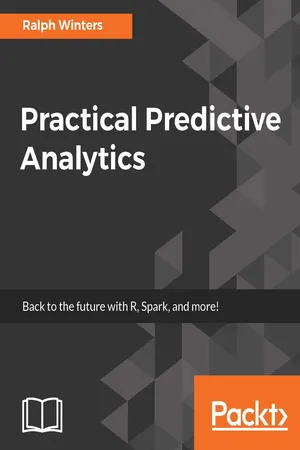
- 576 pages
- English
- ePUB (mobile friendly)
- Available on iOS & Android
Practical Predictive Analytics
About this book
Make sense of your data and predict the unpredictableAbout This Book• A unique book that centers around develop six key practical skills needed to develop and implement predictive analytics• Apply the principles and techniques of predictive analytics to effectively interpret big data• Solve real-world analytical problems with the help of practical case studies and real-world scenarios taken from the world of healthcare, marketing, and other business domainsWho This Book Is ForThis book is for those with a mathematical/statistics background who wish to understand the concepts, techniques, and implementation of predictive analytics to resolve complex analytical issues. Basic familiarity with a programming language of R is expected.What You Will Learn• Master the core predictive analytics algorithm which are used today in business• Learn to implement the six steps for a successful analytics project• Classify the right algorithm for your requirements• Use and apply predictive analytics to research problems in healthcare• Implement predictive analytics to retain and acquire your customers• Use text mining to understand unstructured data• Develop models on your own PC or in Spark/Hadoop environments• Implement predictive analytics products for customersIn DetailThis is the go-to book for anyone interested in the steps needed to develop predictive analytics solutions with examples from the world of marketing, healthcare, and retail. We'll get started with a brief history of predictive analytics and learn about different roles and functions people play within a predictive analytics project. Then, we will learn about various ways of installing R along with their pros and cons, combined with a step-by-step installation of RStudio, and a description of the best practices for organizing your projects.On completing the installation, we will begin to acquire the skills necessary to input, clean, and prepare your data for modeling. We will learn the six specific steps needed to implement and successfully deploy a predictive model starting from asking the right questions through model development and ending with deploying your predictive model into production. We will learn why collaboration is important and how agile iterative modeling cycles can increase your chances of developing and deploying the best successful model.We will continue your journey in the cloud by extending your skill set by learning about Databricks and SparkR, which allow you to develop predictive models on vast gigabytes of data.Style and ApproachThis book takes a practical hands-on approach wherein the algorithms will be explained with the help of real-world use cases. It is written in a well-researched academic style which is a great mix of theoretical and practical information. Code examples are supplied for both theoretical concepts as well as for the case studies. Key references and summaries will be provided at the end of each chapter so that you can explore those topics on their own.
Frequently asked questions
- Essential is ideal for learners and professionals who enjoy exploring a wide range of subjects. Access the Essential Library with 800,000+ trusted titles and best-sellers across business, personal growth, and the humanities. Includes unlimited reading time and Standard Read Aloud voice.
- Complete: Perfect for advanced learners and researchers needing full, unrestricted access. Unlock 1.4M+ books across hundreds of subjects, including academic and specialized titles. The Complete Plan also includes advanced features like Premium Read Aloud and Research Assistant.
Please note we cannot support devices running on iOS 13 and Android 7 or earlier. Learn more about using the app.
Information
Using Market Basket Analysis as a Recommender Engine
- Market basket analysis using the arules package
- Data transformation and cleaning techniques using semi-structured market basket transaction data
- Learn how to transform transaction objects into dataframes
- Use cluster analysis for prediction using the flexclus package
- Utilize some text mining using RTextTools and tm packages
What is market basket analysis?
Examining the groceries transaction file
library(arules)
data(Groceries)
Format of the groceries transaction Files
| Transaction 1 | Milk | Cereal | |
| Transaction 2 | Beef | ||
| Transaction 3 | Butter | Sugar | Cream |

inspect(Groceries[10:19])
items
[1] {whole milk,cereals}
[2] {tropical fruit,other vegetables,white bread,bottled water,chocolate}
[3] {citrus fruit,tropical fruit,whole
milk,butter,curd,yogurt,flour,bottled water,dishes}
[4] {beef}
[5] {frankfurter,rolls/buns,soda}
[6] {chicken,tropical fruit}
[7] {butter,sugar,fruit/vegetable juice,newspapers}
[8] {fruit/vegetable juice}
[9] {packaged fruit/vegetables}
[10]{chocolate}
The sample market basket
Table of contents
- Title Page
- Copyright
- Credits
- About the Author
- About the Reviewers
- www.PacktPub.com
- Customer Feedback
- Preface
- Getting Started with Predictive Analytics
- The Modeling Process
- Inputting and Exploring Data
- Introduction to Regression Algorithms
- Introduction to Decision Trees, Clustering, and SVM
- Using Survival Analysis to Predict and Analyze Customer Churn
- Using Market Basket Analysis as a Recommender Engine
- Exploring Health Care Enrollment Data as a Time Series
- Introduction to Spark Using R
- Exploring Large Datasets Using Spark
- Spark Machine Learning - Regression and Cluster Models
- Spark Models – Rule-Based Learning